ruger BLACKHAWK, SUPER BLACKHAWK, HUNTER, BISLEY User Guide
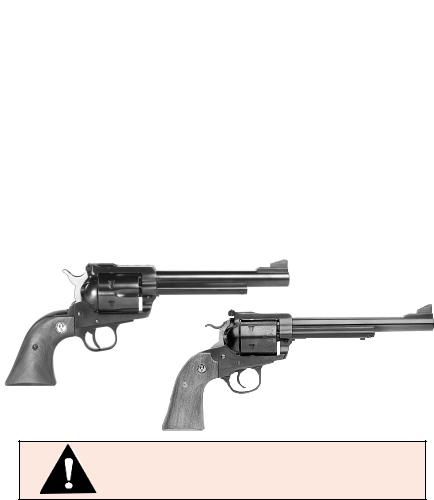
INSTRUCTION
MANUAL
FOR
BLUED & |
CALIBERS |
STAINLESS |
.357 Magnum, |
STEEL |
.30 Carbine, .41 Magnum, |
|
.44 Magnum, & .45LC |
RUGER®
NEW MODEL BLACKHAWK®, SUPER BLACKHAWK®, HUNTER & BISLEY
SINGLE ACTION REVOLVERS
READ THE INSTRUCTIONS AND WARNINGS IN THIS MANUAL CAREFULLY BEFORE USING THIS FIREARM
For Product Service on this Model Please Call: (603) 865-2442 (See p. 27)
STURM, RUGER & Company, Inc.
Southport, Connecticut 06890 U.S.A.
THIS INSTRUCTION MANUAL SHOULD ALWAYS ACCOMPANY THIS FIREARM AND BE TRANSFERRED WITH IT UPON CHANGE OF OWNERSHIP, OR WHEN THE FIREARM IS LOANED OR PRESENTED TO ANOTHER PERSON.
MRN, KMRN & BMRN/4-03 C R6
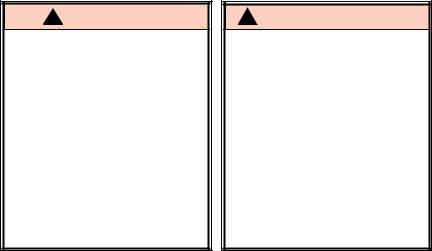
State-By-State Warnings
Certain states require by law that their own specified warning notices in larger-than-normal type be conspicuously included by the manufacturer, distributor, or retail dealer with firearms sold in that state. Sturm, Ruger sells its products in compliance with applicable laws and regulations. Because our products may be sold in these states, we include the following:
California:
! WARNING
“Children are attracted to and can operate firearms that can cause severe injuries or death. Prevent child access by always keeping guns locked away and unloaded when not in use. If you keep a loaded firearm where a child obtains and improperly uses it, you can be fined or sent to prison.”
! ADVERTENCIA
“A los niños los atraen las armas de fuego y las pueden hacer funcionar. Ellos pueden causarses lesions graves y la muerte. Evite que los niños tengan accesso a las armas de fuego guardándolas siempre con llave y descargadas cuando no las esté utilizando. Si usted tiene un arma de fuego cargada en un lugar en que un niño tiene acceso a ella y la usa indebidamente, le pueden dar una multa o enviarlo a la carcel.”
Connecticut:
“UNLAWFUL STORAGE OF A LOADED FIREARM MAY RESULT IN IMPRISONMENT OR FINE.”
Florida:
“IT IS UNLAWFUL, AND PUNISHABLE BY IMPRISONMENT AND FINE, FOR ANY ADULT TO STORE OR LEAVE A FIREARM IN ANY PLACE WITHIN THE REACH OR EASY ACCESS OF A MINOR UNDER 18 YEARS OF AGE OR TO KNOWINGLY SELL OR OTHERWISE TRANSFER OWNERSHIP OR POSSESSION OF A FIREARM TO A MINOR OR A PERSON OF UNSOUND MIND.”
2
Maine:
“ENDANGERING THE WELFARE OF A CHILD IS A CRIME. IF YOU LEAVE A FIREARM AND AMMUNITION WITHIN EASY ACCESS OF A CHILD, YOU MAY BE SUBJECT TO FINE, IMPRISONMENT OR BOTH. KEEP FIREARMS AND AMMUNITION SEPARATE. KEEP FIREARMS AND AMMUNITION LOCKED UP. USE TRIGGER LOCKS.”
Maryland:
“WARNING: Children can operate firearms which may cause death or serious injury. It is a crime to store or leave a loaded firearm in any location where an individual knew or should have known that an unsupervised minor would gain access to the firearm. Store your firearm responsibly!”
Massachusetts:
“WARNING FROM THE MASSACHUSETTS ATTORNEY GENERAL: This handgun is not equipped with a device that fully blocks use by unauthorized users. More than 200,000 firearms like this one are stolen from their owners every year in the United States. In addition, there are more than a thousand suicides each year by younger children and teenagers who get access to firearms. Hundreds more die from accidental discharge. It is likely that many more children sustain serious wounds, or inflict such wounds accidentally on others. In order to limit the chance of such misuse, it is imperative that you keep this weapon locked in a secure place and take other steps necessary to limit the possibility of theft or accident. Failure to take reasonable preventive steps may result in innocent lives being lost, and in some circumstances may result in your liability for these deaths.”
“IT IS UNLAWFUL TO STORE OR KEEP A FIREARM, RIFLE, SHOTGUN OR MACHINE GUN IN ANY PLACE UNLESS THAT WEAPON IS EQUIPPED WITH A TAMPER-RESISTANT SAFETY DEVICE OR IS STORED OR KEPT IN A SECURELY LOCKED CONTAINER.”
3
New Jersey:
“IT IS A CRIMINAL OFFENSE TO LEAVE A LOADED FIREARM WITHIN EASY ACCESS OF A MINOR.”
New York City:
“THE USE OF A LOCKING DEVICE OR SAFETY LOCK IS ONLY ONE ASPECT OF RESPONSIBLE WEAPONS STORAGE. ALL WEAPONS SHOULD BE STORED UNLOADED AND LOCKED IN A LOCATION THAT IS BOTH SEPARATE FROM THEIR AMMUNITION AND INACCESSIBLE TO CHILDREN AND ANY OTHER UNAUTHORIZED PERSONS.”
North Carolina:
“IT IS UNLAWFUL TO STORE OR LEAVE A FIREARM THAT CAN BE DISCHARGED IN A MANNER THAT A REASONABLE PERSON SHOULD KNOW IS ACCESSIBLE TO A MINOR.”
Texas:
“IT IS UNLAWFUL TO STORE, TRANSPORT, OR ABANDON AN UNSECURED FIREARM IN A PLACE WHERE CHILDREN ARE LIKELY TO BE AND CAN OBTAIN ACCESS TO THE FIREARM.”
Wisconsin:
“IF YOU LEAVE A LOADED FIREARM WITHIN THE REACH OR EASY ACCESS OF A CHILD YOU MAY BE FINED OR IMPRISONED OR BOTH IF THE CHILD IMPROPERLY DISCHARGES, POSSESSES, OR EXHIBITS THE FIREARM.”
* * * * * * * * * * * * * * * * * * * * * * *
Please check with your licensed retailer or state police for additional warnings which may be required by local law or regulation. Such regulations change constantly, and local authorities are in the best position to advise you on such legal matters.
4
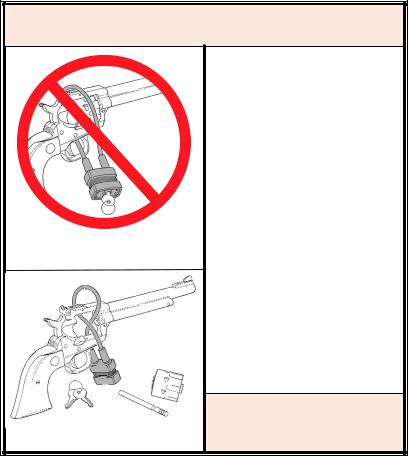
WHY ARE WE INCLUDING A FIRED CARTRIDGE CASE WITH EVERY RUGER PISTOL AND REVOLVER?
Certain states and jurisdictions now require that all newly manufactured pistols and revolvers must be accompanied by a cartridge case, which has been test fired from that gun at the factory. The case must be placed in a sealed container bearing certain information concerning this test cartridge.
At the time of retail sale in those jurisdictions, firearms dealers must forward such test cartridge to a designated destination such as their State Police Laboratory. As independent Ruger Distributors have nationwide markets without territorial restrictions, we have decided to include a fired cartridge case with all new Ruger pistols and revolvers, to minimize the possibility of inadvertent noncompliance with these laws.
Retail customers located in other states, where laws or regulations do not require the dealer to so act, may be assured that the fired cartridge case they receive with the firearm at the time of retail purchase is proof that your new Ruger firearm has undergone our normal test firing procedures during manufacture.
 WARNING – LOCKING DEVICES
WARNING – LOCKING DEVICES
DO NOT INSTALL
INSIDE TRIGGER GUARD
INSTALL LOCK
AS SHOWN HERE
This firearm was originally sold with a key-operated locking device. While it can help provide secure storage for your unloaded firearm, any locking device can fail. All guns are designed to fire if they are loaded and the trigger is pulled. Therefore, never install the locking device inside the trigger guard or in any way that it can possibly pull the trigger!
Do not leave the keys in the lock.
The ultimate responsibility for secure storage of any firearm must depend upon its owner and his or her individual circumstances. Guns should be securely stored unloaded, in a secure location, separate from their ammunition.
See “Storage Warning”, page 24.
NEVER INSTALL
LOCKING DEVICE
INSIDE TRIGGER GUARD
5
FIREARMS SAFETY-YOUR RESPONSIBILITY
SAFETY MUST BE THE FIRST AND CONSTANT CONSIDERATION OF EVERY PERSON WHO HANDLES FIREARMS AND AMMUNITION.
This Instruction Manual is designed to assist you in learning how to use and care for your RUGER® NEW MODEL BLACKHAWK® or BISLEY revolver properly. Please contact us if you have any questions about it.
Only when you are certain you fully understand the Manual and can properly carry out its instructions should you practice loading, unloading, etc. with live ammunition. If you have any doubts about your ability to handle or use a particular type of gun safely, then you should seek supervised instruction.
Such personalized instruction is often available from gun dealers, gun clubs or police departments. If none of these sources can help you, write to the National Rifle Association, 11250 Waples Mill Road, Fairfax, VA 22030-7400. They will assist you.
The person with a gun in their possession has a full-time job. You cannot guess; you cannot forget. You must know how to use your firearm safely. Do not use any firearm without having a complete understanding of its particular characteristics and safe use.
Remember: There is no such thing as a foolproof gun.
TABLE OF CONTENTS
Page
General Information and Mechanical Characteristics . . . . . . . . . . . . . . . . . . . . . 7 Ammunition . . . . . . . . . . . . . . . . . . . . . . . . . . . . . . . . . . . . . . . . . . . . . . . . . . 11 Handling . . . . . . . . . . . . . . . . . . . . . . . . . . . . . . . . . . . . . . . . . . . . . . . . . . . . . 13 To Load and Fire . . . . . . . . . . . . . . . . . . . . . . . . . . . . . . . . . . . . . . . . . . . . . . . 14 To Uncock (Decock) The Revolver . . . . . . . . . . . . . . . . . . . . . . . . . . . . . . . . . . 16 To Unload or Eject Cartridge Cases . . . . . . . . . . . . . . . . . . . . . . . . . . . . . . . . . .17 To Remove or Replace Cylinder . . . . . . . . . . . . . . . . . . . . . . . . . . . . . . . . . . . 17 Disassembly . . . . . . . . . . . . . . . . . . . . . . . . . . . . . . . . . . . . . . . . . . . . . . . . . . . 19 Reassembly . . . . . . . . . . . . . . . . . . . . . . . . . . . . . . . . . . . . . . . . . . . . . . . . . . . 20 Care and Cleaning . . . . . . . . . . . . . . . . . . . . . . . . . . . . . . . . . . . . . . . . . . . . . . 22 Storage . . . . . . . . . . . . . . . . . . . . . . . . . . . . . . . . . . . . . . . . . . . . . . . . . . . . . . .23 Care of Stainless Steel Revolvers . . . . . . . . . . . . . . . . . . . . . . . . . . . . . . . . . . . 24 Attaching Ruger Scope Rings . . . . . . . . . . . . . . . . . . . . . . . . . . . . . . . . . . . . . .25 Sights . . . . . . . . . . . . . . . . . . . . . . . . . . . . . . . . . . . . . . . . . . . . . . . . . . . . . . . . 26 Service and Parts Policy . . . . . . . . . . . . . . . . . . . . . . . . . . . . . . . . . . . . . . . . . . 27 Parts Drawing . . . . . . . . . . . . . . . . . . . . . . . . . . . . . . . . . . . . . . . . . . . . . 37 & 38 The Basic Rules of Safe Firearms Handling . . . . . . . . . . . . . . . . . . . . . . . . . . . 39 Warranty Information . . . . . . . . . . . . . . . . . . . . . . . . . . . . . . . . . . . . . . . . . . . . 44
“Ruger”, “Blackhawk” and “Vaquero” are registered U.S. trademarks.
6

WARNINGS OF GREAT IMPORTANCE ARE
FOUND ON THE FOLLOWING PAGES:
Locking Devices |
5 |
Safe Carrying Position |
15 |
Alterations |
7 |
Disassembly |
18 |
Lead Exposure |
11 |
Lubrication |
23 |
Ammunition |
12 |
Storage |
24 |
Handling |
13 |
Parts Purchasers |
28 |
Firing |
14 |
Malfunctioning Parts |
29 |
OTHER CAUTIONS AND WARNINGS APPEAR
THROUGHOUT THE MANUAL.
FIREARMS ARE DANGEROUS WEAPONS–
READ THE INSTRUCTIONS AND WARNINGS IN THIS MANUAL THOROUGHLY AND CAREFULLY BEFORE USING.
WARNING–ALTERATIONS
This product was designed to function properly in its original condition. Alterations can make it unsafe. Do not alter any part or add or substitute parts or accessories not made by Sturm, Ruger & Co. Inc.
DO NOT ALTER ANY GUN
GENERAL INFORMATION
AND MECHANICAL CHARACTERISTICS
The mechanisms of the RUGER® NEW MODEL BLACKHAWK® differ significantly from that of any other single action revolver. The information and instructions which follow apply only to the New Model Blackhawk* revolver.
The RUGER® NEW MODEL BISLEY revolver has many of the features of the New Model Blackhawk revolvers with certain important differences, such as the hammer, trigger and grip frame. The RUGER® NEW MODEL HUNTER is a .44 magnum single action revolver designed especially for the handgun hunter. A heavier, solid ribbed barrel cut for the patented Ruger scope mounting system distinguishes this model.
*In this manual the words NEW MODEL BLACKHAWK® refer to the
NEW MODEL BLACKHAWK®, NEW MODEL SUPER BLACKHAWK® and RUGER BISLEY revolvers which all utilize the same Ruger New Model Blackhawk mechanism.
7
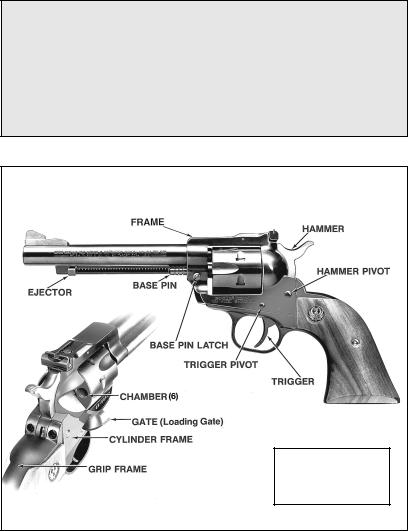
The patented Ruger New Model single action revolver mechanism incorporates a transfer bar. The transfer bar – which is raised into firing position as the trigger is pulled to the rear – transmits the energy of the hammer blow to the firing pin. This transfer bar mechanism makes a “safety” notch unnecessary.
The gate (loading gate) can be opened only when the hammer and trigger are fully forward. Opening the gate immobilizes the trigger, hammer, and transfer bar. When the gate is opened the cylinder is unlatched and can be turned for loading or ejection. When the gate is closed, the cylinder latch functions in the normal manner. The loading notch is therefore unnecessary in the New Model design.
Unlike the earlier single action revolvers which have four hammer positions – “cocked,” “loading,” “safety” and “all the way forward” – the New Model has only two hammer positions – “cocked” and “all the way forward.”
IMPORTANT SAFETY NOTE
OWNERS OF ALL “OLD MODEL” (PRE-1973) RUGER SINGLE ACTION REVOLVERS, INCLUDING BEARCATS WITH SERIAL NUMBERS BELOW 93-00000, SHOULD WRITE FOR DETAILS CONCERNING OUR FREE SAFETY CONVERSION, WHICH CAN HELP PREVENT ACCIDENTS CAUSED BY A BLOW TO THE HAMMER IF THE USER HAS FAILED TO TAKE THE BASIC SAFETY PRECAUTION OF KEEPING AN EMPTY CHAMBER UNDER THE HAMMER. See Page 29.
NOMENCLATURE
New Model Blackhawk*
* In this manual the word Blackhawk refers to both the Blackhawk and the Super Blackhawk models.
Parts referred to frequently are indicated by arrows.
8
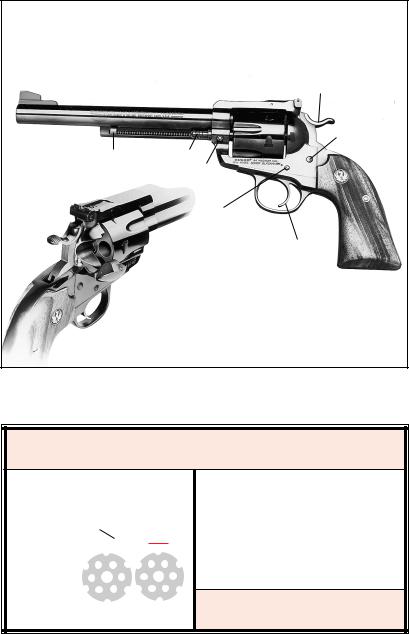
NOMENCLATURE
Bisley
Fluted Cylinder Model Shown
HAMMER
HAMMER |
|
PIVOT |
|
EJECTOR |
BASE PIN |
|
BASE PIN LATCH |
TRIGGER PIVOT
TRIGGER
CHAMBER
GATE (Loading Gate)
CYLINDER FRAME
GRIP FRAME

 CAUTION–NUMBERED CYLINDERS
CAUTION–NUMBERED CYLINDERS
Do not accept delivery of a New Model Blackhawk Convertible (a model with two cylinders) unless the numbers on the front face of both cylinders match the last three digits of the serial number on the frame. Use of the wrong cylinder can cause improper alignment or timing and may result in personal injury.
A Blackhawk revolver (including the Super Blackhawk & Bisley) manufactured with a single cylinder does not have the last three digits of the serial number marked on the cylinder.
CYLINDERS
MUST MATCH GUN
9
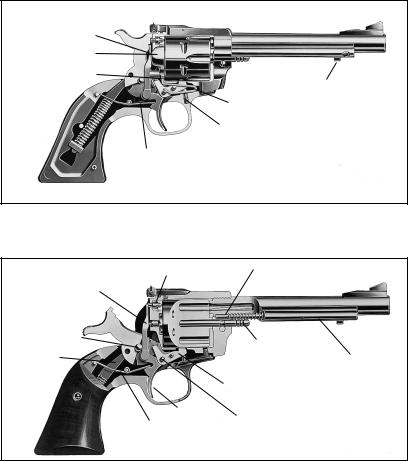
The mechanism of the RUGER® NEW MODEL BLACKHAWK® &
BISLEY provides maximum security against accidental discharge. As with any other firearm, however, the New Model must be used with strict attention to correct safety practices. In addition, the revolver should be inspected frequently to assure that it is working properly.
The Ruger New Model revolver mechanism is illustrated below. The same basic mechanism is found in the entire line of Ruger New Model single action revolvers – Single-Six, Blackhawk, Super Blackhawk, Bisley, Vaquero, Bisley Vaquero, and Hunter Models.
TRANSFER BAR |
|
|
|
LOADING GATE |
|
|
|
LOADING GATE CAM
|
EJECTOR THUMBPIECE |
GATE DETENT SPRING |
|
CYLINDER LATCH SPRING |
|
& PLUNGER |
|
TRIGGER SPRING
Mechanism shown at rest. Transfer bar is not in line between hammer and firing pin. This is the carrying position.
|
|
FIRING PIN |
EJECTOR ROD |
|
|
|
|
|
|
|
TRANSFER |
|
|
|
|
BAR |
|
|
|
HAMMER PIVOT |
|
|
BASE PIN |
|
|
|
|
|
|
MAINSPRING |
|
|
|
EJECTOR HOUSING |
STRUT |
|
|
|
|
|
|
|
|
|
|
|
|
CYLINDER LATCH |
|
|
|
TRIGGER |
TRIGGER & CYLINDER |
|
|
|
TRIGGER SPRING |
LATCH PIVOT |
|
Mechanism shown with trigger pulled and hammer beginning to fall. Transfer bar is in firing position, between hammer and firing pin.
10
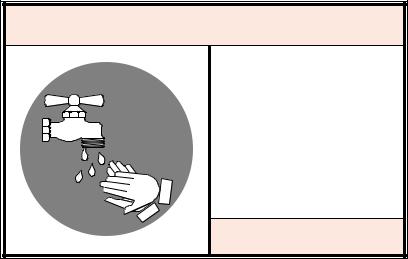
 WARNING - LEAD EXPOSURE
WARNING - LEAD EXPOSURE
Discharging firearms in poorly ventilated areas, cleaning firearms, or handling ammunition may result in exposure to lead and other substances known to the state of California to cause birth defects, reproductive harm, and other serious physical injury. Have adequate ventilation at all times. Wash hands thoroughly after exposure.
SHOOTING OR CLEANING GUNS
MAY EXPOSE YOU TO LEAD
AMMUNITION
The table below shows the correct type of ammunition for use in each of the revolvers listed. Where two cartridges are shown on the same line, they may be used interchangeably.
Model |
Caliber |
Ammunition |
||
Blackhawk Convertible |
.32-20/.32 Mag. |
.32-20 reg. & high speed |
||
|
(no longer in production) |
.32 |
H&R & .32 S&W in Extra Cyl. |
|
|
|
|
||
Blackhawk, Bisley |
.357 Magnum |
.357 Mag. and .38 SPL |
||
|
|
|
||
Blackhawk Convertible |
.357 Mag/9mm |
.357 Mag. and .38 SPL |
||
|
|
|
9mm in Extra Cyl. |
|
|
|
|
|
|
Blackhawk |
.30 |
Carbine |
.30 |
Carbine |
|
|
|
|
|
Blackhawk |
.41 |
Magnum |
.41 |
Magnum |
|
|
|
|
|
Blackhawk, Bisley |
.45 |
Colt |
.45 |
Colt |
|
|
|
|
|
Blackhawk Convertible |
.45 |
Colt/45 Auto |
.45 |
Colt; .45 Auto in Extra Cyl. |
|
|
|
|
|
Super Blackhawk, Hunter, |
.44 |
Magnum |
.44 |
Mag. and .44 SPL |
Blackhawk, Bisley |
|
|
|
|
|
|
|
||
Blackhawk Convertible |
.38-40/10mm |
.38-40 reg. & high speed |
||
|
(no longer in production) |
10mm in Extra Cyl. |
||
|
|
|
||
Super Blackhawk |
.44-40/.44 Mag. |
.44-40 reg. & high speed |
||
Convertible |
(no longer in production) |
.44 |
Mag. & .44 SPL in Extra Cyl. |
|
|
|
|
|
|
11
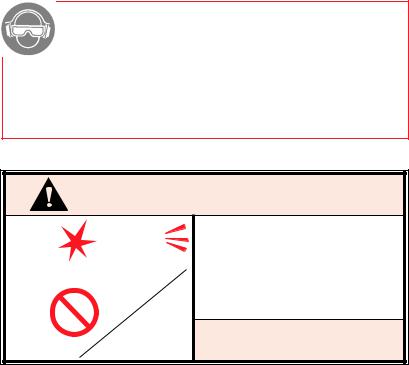
AMMUNITION (CARTRIDGES) NOTICE
WE SPECIFICALLY DISCLAIM RESPONSIBILITY FOR ANY DAMAGE OR INJURY WHATSOEVER OCCURRING IN CONNECTION WITH, OR AS THE RESULT OF, THE USE IN RUGER REVOLVERS OF FAULTY, OR NONSTANDARD, OR “REMANUFACTURED” OR HANDLOADED (RELOADED) AMMUNITION, OR OF CARTRIDGES OTHER THAN THOSE FOR WHICH THE FIREARM WAS ORIGINALLY CHAMBERED.
WARNING – AMMUNITION
Death, serious injury, and damage can result from the use of wrong ammunition, bore obstructions, powder overloads, or incorrect cartridge components. Always wear shooting glasses and hearing protectors.
IMPROPER AMMUNITION
DESTROYS GUNS
Notes on Cartridges listed in the table above: .357 Mag. is 357 Magnum; .38 SPL is .38 Special; 9mm is 9mm Parabellum, also called 9mm Luger; .45 Colt is also called .45 Long Colt; .45 Auto is .45 Automatic and is also called .45 ACP; .44 Mag. is .44 Magnum; .44 SPL is .44 Special.
Notes on the .32-20/.32 Magnum Convertible (this model is no longer in production): The .32-20/.32 magnum revolver is supplied with one .32-20 cylinder and one .32 H&R magnum cylinder. The .32-20 cylinder can fire all
.32-20 factory loaded cartridges, both regular and high speed. No other .32 caliber cartridge should be used in this cylinder, as split cases can result in hot powder gasses escaping rearward under very high velocity. The .32 H&R Magnum cylinder can fire all factory loaded .32 S&W and .32 S&W long cartridges. The use of other than .32 H&R Magnum cartridges may, in some loadings, result in unsatisfactory accuracy.
Notes on the .38-40/10mm Blackhawk Convertible (this model is no longer in production): Ruger New Model Convertible revolvers using the cylinder chambered for the .38-40 cartridge can use all factory loadings of this ammunition both regular and high speed. Do not use any other ammunition in the .38-40 cylinder. Revolvers using the cylinder chambered for the 10mm pistol cartridge can use all factory loadings of this ammunition both regular and high speed. Do not use any other ammunition in the 10mm cylinder.
12
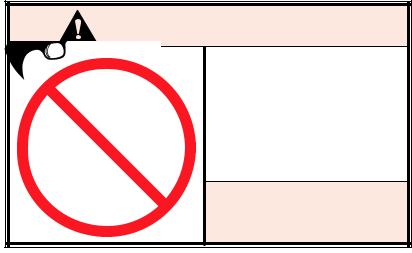
Notes on the .44-40/44 Mag. Super Blackhawk Convertible (this model no longer in production): Ruger New Model Super Blackhawk convertible revolvers using the cylinder chambered for the .44-40 cartridge can use all factory loadings of this ammunition both regular and high speed. Do not use any other ammunition in the .44-40 cylinder. The .44 magnum cylinder can use all factory loadings of the .44 magnum cartridges and .44 special cartridges.
Notes on Revolvers Chambered for 9mm or .30 Carbine: Because 9mm cartridges are manufactured worldwide for use in pistols, revolvers, and submachine guns, it is possible to encounter cartridges which, when fired, develop pierced primers. If this occurs, discontinue the use of the particular brand or type of ammunition. The possibility of a pierced primer is another compelling reason why a shooter should always wear protective glasses to shield his eyes. Use only metal jacketed bullets in 9mm and .30 Carbine revolvers. When a lead bullet is fired, its base expands and a ring of lead is shaved off and deposited in the shoulder area of the chamber. A build-up of lead rings can prevent proper chambering of cartridges because 9mm and .30 Carbine cartridge mouths seat on the chamber shoulders.
When firing a regular .30 Carbine cartridge with a metal jacketed bullet, a ring of brass is sometimes clipped from the mouth of the cartridge case. This ring can lodge in the chamber shoulder and prevent full chambering of a subsequent cartridge. For the reasons noted above, revolver chambers should be cleaned regularly and chamber cleaning should be the first corrective action when cartridges do not chamber properly.
HANDLING
CARRYING: Unlike “old model” single action revolvers, which should always be carried with the hammer down on an empty chamber to prevent accidental discharges caused by a blow to the hammer, the Ruger New Model Blackhawk & Bisley may be carried with all chambers loaded. When the hammer and trigger are fully forward at the same time, the transfer bar is lowered out of firing position and the hammer rests directly on the frame, not on the firing pin.
WARNING – HANDLING
Any time the revolver is loaded, the hammer is cocked and the trigger is pulled and held to the rear, it will fire. Cocking the gun or pulling the trigger should only be done when you are ready to fire immediately.
NEVER DROP OR STRIKE ANY
REVOLVER – COCKED OR UNCOCKED.
CARRY AND HANDLE THE REVOLVER
IN SUCH A MANNER THAT THE
HAMMER WILL NOT BE STRUCK.
NEVER CARRY ANY
REVOLVER WITH THE
HAMMER COCKED.
13
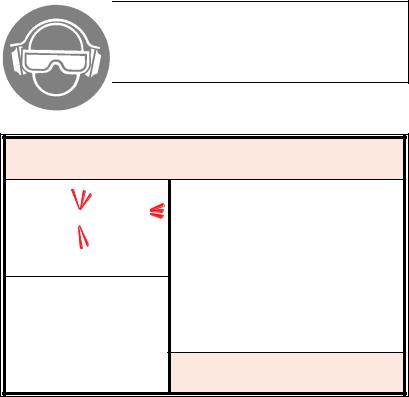
TO LOAD AND FIRE
1.Do not load the revolver until you are ready to use it.
2.Note – The loading gate cannot be opened unless the hammer and trigger are fully forward, and the hammer cannot be cocked once the gate is opened.
3.Open the gate. This permits the cylinder to rotate.
4.Turn cylinder clockwise, by hand, and insert cartridges in chambers.
5.Align a chamber with the barrel and close the gate. The revolver is now in its normal carrying condition – hammer and trigger fully forward and transfer bar lowered out of firing position.
6.Cocking – To fire the revolver, the hammer must first by manually cocked. When cocking the hammer, have a firm hold on the grip with the shooting hand, and DO NOT TOUCH THE TRIGGER WHILE COCKING THE HAMMER. TOUCH THE TRIGGER ONLY WHEN YOU ARE READY TO FIRE. With the fore portion of your thumb firmly on the hammer spur, draw the hammer fully to the rear until it stops. Then permit the hammer to move forward (it will only move slightly) until the trigger engages in the hammer at full cock.
7.Firing – Once the hammer has been cocked, a light pressure on the trigger will disengage the trigger from the hammer. The hammer will fall forward striking the transfer bar and the revolver will fire.
CAUTION: The recoil of any centerfire caliber causes the muzzle of the gun to flip upward with substantial force. The
shooter need not be apprehensive, but be prepared. Keep a firm grip on the revolver and hold it away from your face when firing.
8.After firing, the hammer will remain down. To fire subsequent shots, fully release the trigger and repeat steps 6 & 7 above for each shot.
 WARNING – FIRING
WARNING – FIRING
When firing any revolver, be sure all persons are a safe distance to the rear of the shooter. When fired, all revolvers discharge gas and particles through the clearance gap between the cylinder and the rear of the barrel. These particles of lead, powder grains or lubricant are projected broadly sideways at high speed and thus can injure a person who is standing too close to the revolver. When firing any revolver, always be certain that nothing – including either of your hands – is in the path of the hot gas and particles which are discharged from the front and sides of the cylinder. When shooting, adequate eye protection is essential. Shooters and bystanders must wear shooting glasses. Hearing protection must also be worn. Exposure to shooting noise can damage hearing.
HOT GASES EXIT
BARREL/CYLINDER GAP
14
